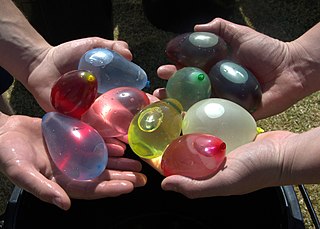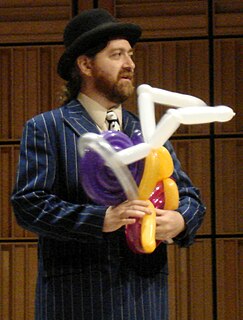
A condom is a sheath-shaped barrier device used during sexual intercourse to reduce the probability of pregnancy or a sexually transmitted infection (STI). There are both male and female condoms. With proper use—and use at every act of intercourse—women whose partners use male condoms experience a 2% per-year pregnancy rate. With typical use the rate of pregnancy is 18% per-year. Their use greatly decreases the risk of gonorrhea, chlamydia, trichomoniasis, hepatitis B, and HIV/AIDS. They also to a lesser extent protect against genital herpes, human papillomavirus (HPV), and syphilis.

Natural rubber, also called by other names of India rubber, latex, Amazonian rubber, caucho or caoutchouc, as initially produced, consists of polymers of the organic compound isoprene, with minor impurities of other organic compounds, plus water. Thailand and Indonesia are two of the leading rubber producers. Types of polyisoprene that are used as natural rubbers are classified as elastomers.

A weather or sounding balloon is a balloon that carries instruments aloft to send back information on atmospheric pressure, temperature, humidity and wind speed by means of a small, expendable measuring device called a radiosonde. To obtain wind data, they can be tracked by radar, radio direction finding, or navigation systems. Balloons meant to stay at a constant altitude for long periods of time are known as transosondes. Weather balloons that do not carry an instrument pack are used to determine upper-level winds and the height of cloud layers. For such balloons, a theodolite or total station is used to track the balloon's azimuth and elevation, which are then converted to estimated wind speed and direction and/or cloud height, as applicable.

A radiosonde is a battery-powered telemetry instrument carried into the atmosphere usually by a weather balloon that measures various atmospheric parameters and transmits them by radio to a ground receiver. Modern radiosondes measure or calculate the following variables: altitude, pressure, temperature, relative humidity, wind, cosmic ray readings at high altitude and geographical position (latitude/longitude). Radiosondes measuring ozone concentration are known as ozonesondes.

A water balloon or water bomb is a latex rubber balloon filled with water. Water balloons are used in a summer pastime of cooling off through water balloon wars. Water balloons are also popular for celebrations, including celebrating Holi and Carnival in India, Nepal, and several other countries.

In urinary catheterization a latex, polyurethane, or silicone tube known as a urinary catheter is inserted into the bladder through the urethra. Catheterization allows urine to drain from the bladder for collection. It may also be used to inject liquids used for treatment or diagnosis of bladder conditions. A clinician, often a nurse, usually performs the procedure, but self-catheterization is also possible. A catheter may be in place for long periods of time or removed after each use.

Latex allergy is a medical term encompassing a range of allergic reactions to the proteins present in natural rubber latex. Latex allergy generally develops after repeated exposure to products containing natural rubber latex. When latex-containing medical devices or supplies come in contact with mucous membranes, the membranes may absorb latex proteins. The immune system of some susceptible individuals produces antibodies that react immunologically with these antigenic proteins. As many items contain or are made from natural rubber, including shoe soles, elastic bands, rubber gloves, condoms, baby-bottle nipples, and balloons, there are many possible routes of exposure that may trigger a reaction. People with latex allergies may also have or develop allergic reactions to some fruits, such as bananas.

High-altitude balloons are manned or unmanned balloons, usually filled with helium or hydrogen, or in some cases methane, that are released into the stratosphere, generally attaining between 18 and 37 km above sea level. In 2002, a balloon named BU60-1 reached a record altitude of 53.0 km.

A toy balloon or party balloon, is a small balloon mostly used for decoration, advertising and children's toys. Toy balloons are usually made of rubber or aluminized plastic, and inflated with air or helium. They come in a great variety of sizes and shapes, but are most commonly 10 to 30 centimetres in diameter. Toy balloons are not considered to include "sky lanterns", although these too are or were used as child toys in some parts of the world.
A balloon helicopter is a flying toy consisting of a latex toy balloon and a plastic propeller, derived from the simple balloon rocket. The most important feature is the hollow propeller hub which directs air into a passage in each propeller blade. The air passages channel air to the blade tips such that air escapes in a fine jet tangentially. The air jets on the blade tips causes the entire toy to spin, the blades have a positive angle of attack so the blades experience a lifting force as they push air downwards. It can attain a height of approximately 12 meters (40 feet). Full-scale helicopters have been built around this tip jet configuration.

A mule or courier is someone who personally smuggles contraband across a border for a smuggling organization. The organizers employ mules to reduce the risk of getting caught themselves. Methods of smuggling include hiding the goods in vehicles or carried items, attaching them to one's body, or using the body as a container.

Balloon tamponade usually refers to the use of balloons inserted into the esophagus, stomach or uterus, and inflated to alleviate or stop refractory bleeding.
FITkit is an immunological test for measuring natural rubber latex (NRL) allergens from a variety of rubber products, such as gloves.

Lawrence “Larry” Charles Moss (born September 25, 1970) is an American artist, author and educator who works mainly with latex balloons. He is renowned, in the field of large-scale balloon sculpture as art installation, for creating technically and aesthetically challenging sculptures which often incorporate literary, art and pop culture references. In March 2015, The Washington Post ran a profile on Moss which identified him as "the best balloon artist in the world."

Latex is a stable dispersion (emulsion) of polymer microparticles in an aqueous medium. It is found in nature, but synthetic latexes can be made by polymerizing a monomer such as styrene that has been emulsified with surfactants.
Vytex Natural Rubber Latex (NRL) is a brand of natural rubber latex produced and marketed by Vystar Corporation. Vytex NRL is an alternative material to petroleum-based synthetics and traditional, or Hevea, natural rubber latex. Protein test results show that Vytex NRL typically has 90% fewer antigenic proteins than Hevea natural rubber latex.
Neil E. Tillotson was the inventor of the modern latex balloon and latex gloves and founder of Tillotson Rubber Company. Later, as a resident of Dixville Notch, New Hampshire, he was the first voter in every American presidential primary and presidential election from the time he took residence there to his death in 2001.

A balloon fetish is a sexual fetish that involves balloons. A balloon fetishist is also referred to as a "looner". Some balloon fetishists "revel in the popping of balloons and [others] may become anxious and tearful at the very thought of popping balloons". Others enjoy blowing up balloons or sitting and lying on them.

A balloon is a flexible bag that can be inflated with a gas, such as helium, hydrogen, nitrous oxide, oxygen, air. For special tasks, balloons can be filled with smoke, liquid water, granular media, or light sources. Modern day balloons are made from materials such as rubber, latex, polychloroprene, or a nylon fabric, and can come in many different colors. Some early balloons were made of dried animal bladders, such as the pig bladder. Some balloons are used for decorative purposes or entertaining purposes, while others are used for practical purposes such as meteorology, medical treatment, military defense, or transportation. A balloon's properties, including its low density and low cost, have led to a wide range of applications.
An air bladder effect, or simply a bladder effect, is a special effect created for motion pictures. The effect employs plastic or latex balloons—known as "bladders"—which are concealed beneath the surface of foam latex or similar prosthetics. Attached to the bladders is a system of tubing that allows them to be inflated. When the bladders are inflated underneath the prosthetics, it results in the prosthetics appearing to shift, bubble, swell, or pulsate.














